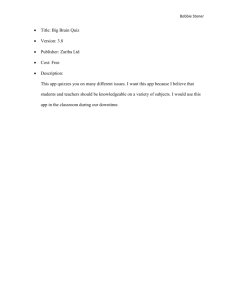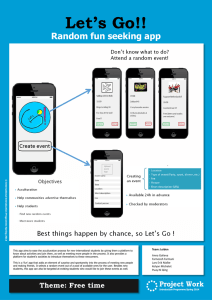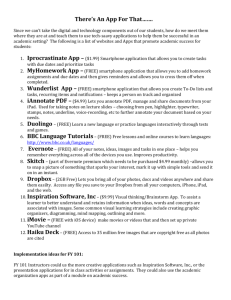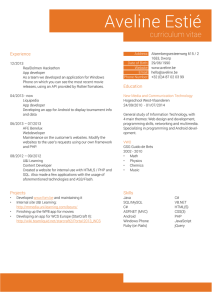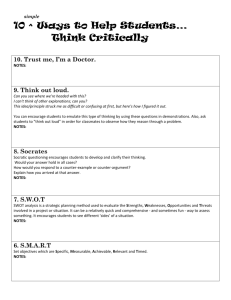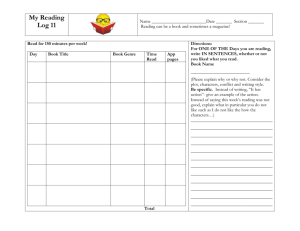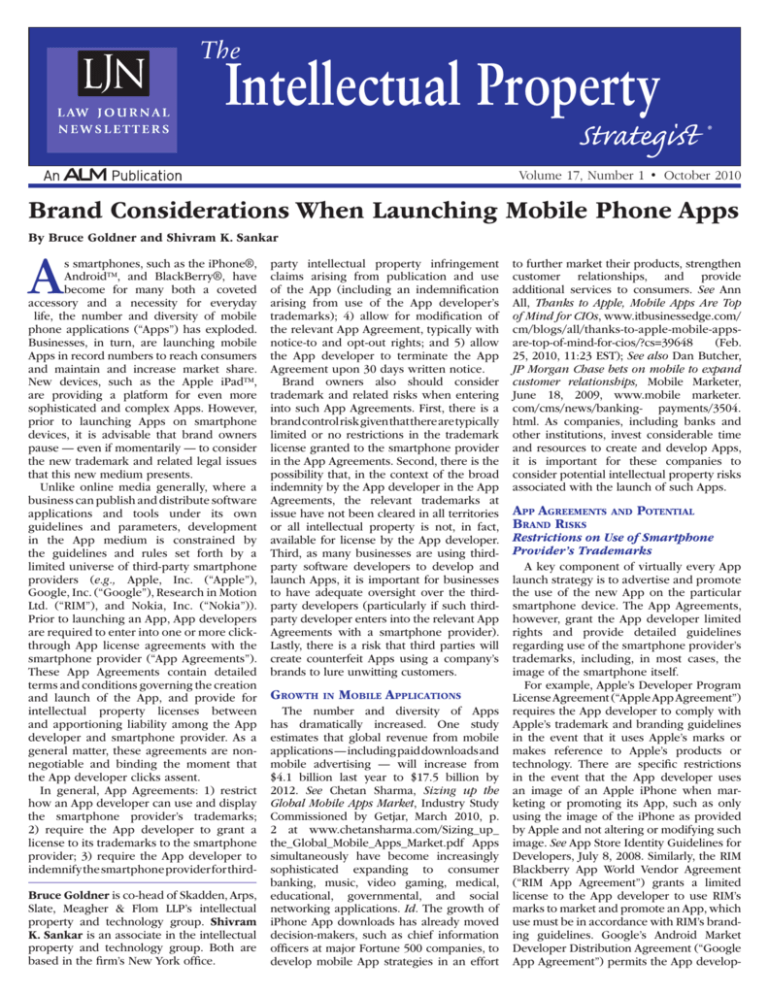
The
Intellectual Property
Strategist
®
Volume 17, Number 1 • October 2010
Brand Considerations When Launching Mobile Phone Apps
By Bruce Goldner and Shivram K. Sankar
A
s smartphones, such as the iPhone®,
Android™, and BlackBerry®, have
become for many both a coveted
accessory and a necessity for everyday
life, the number and diversity of mobile
phone applications (“Apps”) has exploded.
Businesses, in turn, are launching mobile
Apps in record numbers to reach consumers
and maintain and increase market share.
New devices, such as the Apple iPad™,
are providing a platform for even more
sophisticated and complex Apps. However,
prior to launching Apps on smartphone
devices, it is advisable that brand owners
pause — even if momentarily — to consider
the new trademark and related legal issues
that this new medium presents.
Unlike online media generally, where a
business can publish and distribute software
applications and tools under its own
guidelines and parameters, development
in the App medium is constrained by
the guidelines and rules set forth by a
limited universe of third-party smartphone
providers (e.g., Apple, Inc. (“Apple”),
Google, Inc. (“Google”), Research in Motion
Ltd. (“RIM”), and Nokia, Inc. (“Nokia”)).
Prior to launching an App, App developers
are required to enter into one or more clickthrough App license agreements with the
smartphone provider (“App Agreements”).
These App Agreements contain detailed
terms and conditions governing the creation
and launch of the App, and provide for
intellectual property licenses between
and apportioning liability among the App
developer and smartphone provider. As a
general matter, these agreements are nonnegotiable and binding the moment that
the App developer clicks assent.
In general, App Agreements: 1) restrict
how an App developer can use and display
the smartphone provider’s trademarks;
2) require the App developer to grant a
license to its trademarks to the smartphone
provider; 3) require the App developer to
indemnify the smartphone provider for thirdBruce Goldner is co-head of Skadden, Arps,
Slate, Meagher & Flom LLP’s intellectual
property and technology group. Shivram
K. Sankar is an associate in the intellectual
property and technology group. Both are
based in the firm’s New York office.
party intellectual property infringement
claims arising from publication and use
of the App (including an indemnification
arising from use of the App developer’s
trademarks); 4) allow for modification of
the relevant App Agreement, typically with
notice-to and opt-out rights; and 5) allow
the App developer to terminate the App
Agreement upon 30 days written notice.
Brand owners also should consider
trademark and related risks when entering
into such App Agreements. First, there is a
brand control risk given that there are typically
limited or no restrictions in the trademark
license granted to the smartphone provider
in the App Agreements. Second, there is the
possibility that, in the context of the broad
indemnity by the App developer in the App
Agreements, the relevant trademarks at
issue have not been cleared in all territories
or all intellectual property is not, in fact,
available for license by the App developer.
Third, as many businesses are using thirdparty software developers to develop and
launch Apps, it is important for businesses
to have adequate oversight over the thirdparty developers (particularly if such thirdparty developer enters into the relevant App
Agreements with a smartphone provider).
Lastly, there is a risk that third parties will
create counterfeit Apps using a company’s
brands to lure unwitting customers.
Growth
in
Mobile Applications
The number and diversity of Apps
has dramatically increased. One study
estimates that global revenue from mobile
applications — including paid downloads and
mobile advertising — will increase from
$4.1 billion last year to $17.5 billion by
2012. See Chetan Sharma, Sizing up the
Global Mobile Apps Market, Industry Study
Commissioned by Getjar, March 2010, p.
2 at www.chetansharma.com/Sizing_up_
the_Global_Mobile_Apps_Market.pdf Apps
simultaneously have become increasingly
sophisticated expanding to consumer
banking, music, video gaming, medical,
educational, governmental, and social
networking applications. Id. The growth of
iPhone App downloads has already moved
decision-makers, such as chief information
officers at major Fortune 500 companies, to
develop mobile App strategies in an effort
to further market their products, strengthen
customer relationships, and provide
additional services to consumers. See Ann
All, Thanks to Apple, Mobile Apps Are Top
of Mind for CIOs, www.itbusinessedge.com/
cm/blogs/all/thanks-to-apple-mobile-appsare-top-of-mind-for-cios/?cs=39648
(Feb.
25, 2010, 11:23 EST); See also Dan Butcher,
JP Morgan Chase bets on mobile to expand
customer relationships, Mobile Marketer,
June 18, 2009, www.mobile marketer.
com/cms/news/banking- payments/3504.
html. As companies, including banks and
other institutions, invest considerable time
and resources to create and develop Apps,
it is important for these companies to
consider potential intellectual property risks
associated with the launch of such Apps.
App Agreements
Brand Risks
and
Potential
Restrictions on Use of Smartphone
Provider’s Trademarks
A key component of virtually every App
launch strategy is to advertise and promote
the use of the new App on the particular
smartphone device. The App Agreements,
however, grant the App developer limited
rights and provide detailed guidelines
regarding use of the smartphone provider’s
trademarks, including, in most cases, the
image of the smartphone itself.
For example, Apple’s Developer Program
License Agreement (“Apple App Agreement”)
requires the App developer to comply with
Apple’s trademark and branding guidelines
in the event that it uses Apple’s marks or
makes reference to Apple’s products or
technology. There are specific restrictions
in the event that the App developer uses
an image of an Apple iPhone when marketing or promoting its App, such as only
using the image of the iPhone as provided
by Apple and not altering or modifying such
image. See App Store Identity Guidelines for
Developers, July 8, 2008. Similarly, the RIM
Blackberry App World Vendor Agreement
(“RIM App Agreement”) grants a limited
license to the App developer to use RIM’s
marks to market and promote an App, which
use must be in accordance with RIM’s branding guidelines. Google’s Android Market
Developer Distribution Agreement (“Google
App Agreement”) permits the App develop-
LJN’s The Intellectual Property Strategist
er to use Google’s Android trademark, but
not the Google trademark, when marketing
or promoting an App. Nokia’s Ovi Store
Publisher Registration and Distribution
Agreement (“Nokia App Agreement”) prohibits most uses of Nokia’s trademarks, even
for marketing or promotional purposes.
As companies increasingly launch
campaigns to promote their Apps, they
should verify that marketing and advertising
which depict a smartphone or reference
a smartphone provider comply with the
detailed guidelines and restrictions set forth
in the applicable App Agreement.
License to App Developer’s Marks
App Agreements uniformly require that
the App developer grant a royalty-free
license to its trademarks to the smartphone
provider both for use in a relevant App store
and for marketing and promotional purposes. The App Agreements generally do not
define precisely which trademarks of the App
developer are subject to the license to the
smartphone provider. Although certain App
Agreements state that all names and marks
owned or licensed by the App developer
are subject to the license (e.g., the Google
App Agreement and Nokia App Agreement),
other App Agreements indicate that the
license may be limited to names and marks that
appear in the App or otherwise are provided
to the smartphone provider (e.g., the Apple
App Agreement and RIM App Agreement).
The App Agreements vary with respect to
the degree of control reserved to the App
developer regarding the use of its marks by
the smartphone provider. Under the RIM
App Agreement, the App developer has a
right to consent to the use of its marks by
RIM if such use is for purposes not related to
the RIM App store (e.g., for general marketing or promotional purposes) or if the App
developer’s marks are modified by RIM.
Other App Agreements, however, such as the
AppleAppAgreement,GoogleAppAgreement,
and Nokia App Agreement, do not expressly
provide that the App developer consent to the
smartphone provider’s use of its trademarks.
The broad trademark licenses contained
in the App Agreements potentially could
raise branding and other concerns for App
developers, as the controls and approvals
that they generally may require of a
licensee may not be present in these form
agreements. The potential branding risks
here, however, are unlikely to give rise to
actual risk given that smartphone providers
in practice use such brands to identify and
promote the App developer’s App, not to
designate a new or different product or
service, and frequently consult with the App
developer with respect to prominent uses of
such brands in advertising campaigns and
the like. Nevertheless, a company should
consider monitoring the use of its marks by
the smartphone provider, either formally, by
engaging a trademark monitoring service,
or informally, by relying on the marketing
October 2010
department, legal department, and other
company employees to report misuses of
its trademarks by the smartphone provider
in the marketplace.
Amendments to the App
Agreements
Any analysis of the terms and conditions
of and potential legal risks associated with
App Agreements must take into account
that the App Agreements may change. App
Agreements generally provide that the App
Agreement may be amended by the smartphone provider at any time, provided that
the App developer is given written notice of
such changes, (most of the App Agreements
additionally provide that the App developer
must affirmatively consent to such amendments). However, as a practical matter, the
person receiving notification of a revised
App Agreement may be an IT specialist at
the company or an outside IT service provider who uploads the relevant App. Thus,
this person may not be evaluating the potential legal impact of such amendments.
Accordingly, a company launching Apps
should consider including its legal counsel
in the App launch process or otherwise
actively monitor amendments to the App
Agreements.
Indemnification of
Third-Party Claims
App Agreements typically require
the App developer to indemnify the
smartphone provider against third-party
intellectual property infringement claims
related to the App (including third-party
trademark infringement claims arising
from the smartphone provider’s use of the
App developer’s trademarks).
It is important, therefore, for an App
developer to ensure that its trademarks,
graphical content in the App, and the
technology underlying the App are owned
by or licensed to the relevant App developer,
and that the associated intellectual property
rights have been properly cleared. Further,
with respect to technology, content and
other intellectual property rights developed
or provided by third parties, the App
developer should obtain from these third
parties appropriate indemnification, so
that claims by a smartphone provider may
be covered by the third-party provider
indemnity. Finally, the App developer should
ensure that any third-party rights associated
with the App are sublicenseable, as the App
Agreements automatically subject such rights
to a sublicense to the smartphone provider.
There is an additional risk, in that the
trademark license granted to the smartphone provider typically is worldwide, even
though the trademarks used in or associated with the App may not have been cleared
in all relevant jurisdictions. As a practical
matter, the risk may be mitigated as the
smartphone provider likely would promote
the availability of the App only in those
jurisdictions in which the App is targeted
and intended. Nonetheless, brand owners
should appreciate that Apps present yet
another potentially “borderless” new media,
which could expose the App developer to
legal liability in countries where its brands
have not been cleared and protected.
Use of Third-Party Developers
As companies have sought to rapidly
expand their App portfolio, they have
increasingly relied on third-party software
development companies that specialize in
developing Apps, which have the ability
to more quickly and cost-effectively create
Apps on a company’s behalf.
In such instances, the third-party technology provider, not the company, may be
the party entering into the App Agreement.
Therefore, the company may have to rely
on the technology provider to exercise the
company’s rights and remedies under the
App Agreement, and provide all relevant notices received from the smartphone provider.
Accordingly, agreements with third-party
technology providers that will be launching
the App should contain provisions concerning prompt notice, cooperation, and consent
rights regarding the App Agreements.
Counterfeiting
Finally, as with all new frontiers in which
brands are present, there is the potential for
significant counterfeiting of famous marks
and brands in the App context. Specifically,
certain App publishers are labeling their Apps
with popular brands, without authorization
of the brand owner, to catch the attention
of smartphone users. Accordingly, brand
owners should consider adopting policies
regarding monitoring and enforcement of
their trademarks with respect to smartphone
applications, akin to policing policies that
they already pursue with respect to domain
names and the Internet.
Conclusion
Apps have arrived and are literally everywhere. They are revolutionizing how
companies market their products, provide
services to consumers, and expand their
market reach. However, as with any new
medium, they present their own novel legal
challenges. Prior to launching Apps, companies should consider the potential branding
and intellectual property risks and formulate
a policy and procedure as to how best to
address them. In addition, following App
launch, companies should continue to monitor how their intellectual property is being
used under an App Agreement, so that they
are in a position to act swiftly with respect
to misuses and infringements of brands and
other intellectual property in an App world.
—❖—
Reprinted with permission from the October 2010 edition of
the Law Journal Newsletters. © 2010 ALM Media
Properties, LLC. All rights reserved. Further duplication without
permission is prohibited. For information, contact 877.257.3382
or reprints@alm.com. #055081-10-10-07

